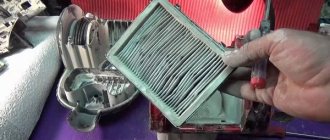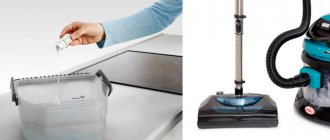The hose from the vacuum cleaner breaks, what should I do?
The most common cause of hose failure is a break. It can break:
- at the base of the vacuum cleaner - due to frequent twisting and improper storage;
- in the middle of the corrugation - if used incorrectly (if sharp objects get into it during cleaning or if sudden movements are made when using a vacuum cleaner).
Repairs can be performed in the following ways:
- using a simple cut;
- applying a bandage;
- thermal method.
Below we will look at these methods in more detail.
Types of pipes
They are distinguished by the material they are made of. There are plastic and steel tubes. Steel ones are more durable. But plastic ones are easier to use. Although they break easily.
Modern vacuum cleaners are made with durable clamps on the tubes. They are the ones who often make it difficult to disassemble the element.
Telescopic pipe device
The telescopic suction pipe is an integral system consisting of two tubes: external and internal. They have one or more stupor elements built into them, which are fixed in the internal grooves of the sleeve. This keeps the inner tube in place. The system is secured by a special built-in spring.
Vacuum cleaner hose extension
In some cases (cleaning large rooms, hard-to-reach areas), the hose may not be enough. Then it can be extended up to 5 m. In order to do this, you need to select the same diameter and pitch of the coil. Prepare the ends to be joined in advance: sand and degrease. Lengthening can be done in three ways.
- Using a bicycle camera. Cut a piece of 5-6 cm from the camera and put it on the surfaces to be joined. Fill the places of contact with the corrugation with cold welding or rubber glue.
- Using a simple corrugated pipe. Take a 10 cm piece from the corrugated pipe and, cutting it lengthwise, put it on the junction of two hoses (you can screw one hose into the other). Wrap this place with tape or tape.
- Using a half-liter plastic bottle. Cut the bottle on both sides to create a sleeve. Place it on one end of the hose and attach the other so that the bottle is in the center of the connection. Warm up this place with a hair dryer. The plastic will shrink and seal the joint tightly.
The most common malfunctions
If it is not possible to take the vacuum cleaner to a specialist to disassemble and assess its condition, you can find out what you need to pay attention to in the event of a malfunction. After problems arise, the first thing to check is the bearings, which help the engine run.
A specialist can quickly determine the problem of a vacuum cleaner breakdown.
The sound that is characteristic of them: a sharp hum, roar, burning, overheating of the body. In addition to them, attention is paid to the armature and motor brush. A common problem is that the hose does not draw in contaminants.
Vacuum cleaner hoses often fray.
The reason may be a clogged hose, an overfilled dust bag, or a problem with the HEPA filter. A problem that often arises is when the unit draws air, but the debris is not removed properly. The problem may be a worn brush or a broken roller position.
Motor failure is a serious problem.
If the equipment does not turn on and the electricity does not disappear, then the reason lies in: the overheating protection or malfunction of the power circuit, plug, wire, internal wires, or a snag in the switch itself. If the problem occurs with the electronics, it is better to entrust this matter to a professional.
Only a professional service center will quickly repair your vacuum cleaner.
An indicator of this lies in the fact that during operation they discovered smoke, knocked out plugs, and short circuits. This all suggests that the problem is centered on a short circuit inside the device. And frequent problems with collector sparking lead to rapid wear of the device.
Use the drawings to disassemble the vacuum cleaner.
Why is the hose whistling?
When choosing a hose, special attention should be paid to checking its internal part: it should be smooth, without protruding ribs. If the surface is ribbed, then when cleaning, air clings to the ribs, forming turbulence inside the pipe, which causes a whistle. This can also happen when cellophane or other objects get inside. You need to unscrew the hose and check if there are any blockages inside it. If there is, clean them using a wire hook, the rounded end of a ruler or cable.
Useful tips
- In case of any malfunction of the vacuum cleaner, regardless of the manufacturer, it is recommended to disassemble the device from the base. What if it’s not a problem at all? If you are still sure that the breakdown is in the telescope, then you should not touch the engine and other important elements.
- If foreign objects get stuck in the pipe, you can try and pull them out indiscriminately. To do this, you need to find a long metal or wooden stick with a diameter smaller than the inner tube. Push the stick inside the telescope and remove the object from the other side. Of course, disconnect the tube from the base of the vacuum cleaner in advance.
- The fasteners on the pipe are opened by pressing firmly on them at the same time. But this cannot be done with your fingers. You need a convenient device.
To avoid even bigger problems with your equipment, it is better to take it in for repair.
Source
Applying a bandage
Such repairs are performed for punctures, ruptures, or cuts in the hose. A bicycle inner tube is used as a bandage, as it can stretch well.
Expert opinion
Alena Tsarevskaya
Subpage for an expert
If during repairs you take a chamber of smaller diameter than the hose and glue it, this will allow you to tighten the joint more tightly and firmly.
Repairs are carried out in the following order:
- Cut off the damaged area.
- Clean and degrease the cuts.
- Prepare a piece of bicycle tube 80-100 mm.
- Place this piece further than the damaged part.
- Apply glue to the ends of the cuts and the surface at the junction.
- Put the camera on, completely covering the joint.
Rules of care and use
The service life of the vacuum cleaner largely depends on the wear and tear of the plastic. The pipes used in vacuum cleaners are made of thin, flexible polyvinyl chloride with a ribbed surface.
The manufacturer's instructions contain direct or indirect instructions on how to handle the hose during operation of the vacuum cleaner:
- during storage, the position of the air intake, which is not separated from the body, is determined by fixing the floor nozzle;
- after cleaning, the detachable sleeve is stored in the provided compartment of the box;
- the vacuum cleaner should be moved around the room by the handle on the body, and not by the hose;
- Do not use a vacuum cleaner to remove sharp objects, scraps of paper or cloth.
To make a polymer hose last longer, you cannot:
- bend it at an angle of more than 30 degrees;
- step on it, place heavy objects on it;
- store at temperatures below 0 degrees;
- place next to operating heating devices (battery, heater, stove, fireplace).
If a whistle or weak suction occurs, you must lay the hose horizontally and check for blockages with foreign objects using a long stick or metal wire. A wall holder can be purchased as additional equipment. An arched metal chute is mounted in a utility room or in a niche where the vacuum cleaner is stored. The design of the holder will protect the hose from kinks and twisting.
How to disassemble a vacuum cleaner hose
In order to determine the cause of the hose failure, you need to disassemble it and check for external damage, ruptures, blockages, and then take appropriate repair measures. Instructions:
- Unscrew the hose holder.
- Remove the fastening mechanism.
- Remove the latch.
- Unscrew the hose guide and remove it.
- Remove the hose and repair it.
- Reassemble.
Repair methods
If the hose breaks, jumps out of the wall chaser, flies out of the adapter, bursts, comes off, gets clogged or breaks, experts recommend replacing the damaged part and not rushing to send the device in for repair. Having a minimal set of tools, each owner can repair the device independently.
Basic methods for repairing corrugated parts:
- removal of the deformed area;
- applying a bandage;
- the use of a thermal method;
- electrical line hose repair;
- temporary fastening of adhesive tapes.
The first option is the simplest way to restore the integrity of a part, which requires a minimum set of tools. To remove the damaged area, you need to make an even cut at the break site, remove the cut section from the end piece, cover the cut line with a sealant and insert the whole hose into the end piece.
Many models of vacuum cleaners have collapsible end switches with nylon bushings. The thread on the sleeve secures the hose. To repair this device, you need to disconnect the clamps, change the ring plug and remove the bushing with the deformed area. After trimming the damaged area, you need to reassemble the structure in the reverse order.
The second option for hose deformation is characterized by the presence of mechanical damage in the form of cuts and ruptures caused by careless operation of household appliances. The material for creating a bandage can be ordinary rubber from a bicycle, which has a high level of elasticity and fits tightly to the hose.
The repair process consists of the following stages:
- trimming the damaged area;
- cleaning the end parts of the hose;
- preparing the required piece of bicycle rubber, the length of which should be no more than 15 cm;
- attaching a rubber bandage to the damaged area;
- connecting the ends of the hose using a special adhesive;
- lubricating the bandage attachment point with universal glue;
- tightly attach a piece of the camera to the hose and securely fix it until the glue dries completely.
Repairing a corrugated part using a heat gun and heat-shrinkable material is the most complex method, which is highly reliable and durable. Advantages - no need to remove a deformed piece of hose, the ability to repair any damaged area. The disadvantage is the presence of a special construction hair dryer. Main stages of repair work:
- selection of heat-shrinkable material in accordance with the diameter and color of the hose;
- dismantling the limit switch from the undamaged side;
- fixing the thermal material at the rupture site;
- uniform heating of the rubber pad along its entire length.
This electrical device is installed on devices that have an air flow control sensor. The peculiarity of the repair is the removal of the damaged area along with electrical wires that will require reconnection. Repair activities:
- disassembling the pipe body;
- disconnecting the pipe from the hose;
- dismantling the defective part of the pipe;
- soldering contact pins to conductors;
- assembly of the structure.
Among the main disadvantages of this device with an electric control sensor, experts highlight the possible deformation of the hose at the junction with the handle and the rupture of only the electrical wires.
To quickly perform temporary repairs, experts recommend using tape, masking tape and electrical tape, which will help cover the damaged area for a short period of time.
Stages of repair activities:
- cleaning and degreasing the area where the adhesive material is applied;
- attaching the selected adhesive tape in two or three layers;
- fixing the end of the tape with glue.
This design cannot replace a full-fledged repair and has a short operational period, but it can become a quick way to resuscitate the device.
Particular attention should be paid to the occurrence of a specific whistle and smell that the hose can emit during operation, as well as a sharp decrease in suction power. The main reason for this type of failure is the presence of a foreign object inside the corrugated pipe
Most often, craftsmen remove small children's toys, socks, handkerchiefs, paper and plastic bags. Even an inexperienced craftsman can fix this type of problem with his own hands by inserting a thick wire or piece of reinforcement into the corrugated cavity. You can disassemble the device, clean and repair it, take out a sock, take out a toy, and get rid of the smell within a few minutes.
To learn how to repair a vacuum cleaner hose using heat shrink, watch the following video.
Vacuum cleaner hose diameter
Hoses for modern vacuum cleaners have the following internal diameters: 32, 36, 38, 50. The hose connection can be connected to the inlet of the vacuum cleaner with a thread of dimensions, mm:
| Outside diameter | 44 + 0,3 (+0,1) |
| Inner diameter | 38 + 0,3 (+0,1) |
| Thread pitch | 6 + 0,1 |
The vacuum cleaner hose is a very important component. If it breaks, the vacuum cleaner may become unusable. The hose may break due to improper storage or use. Buying a new hose is not always possible due to the lack of components for this model of vacuum cleaner or the high cost of a new hose. In some cases, you can repair the hose yourself in various ways: using a simple cut, applying a bandage, or the thermal method. After such repairs, the hose can last for several more years.
You will find more interesting information on this topic in the “ Repair ” section of our portal.
Causes of defects
Cracks, tears, and punctures on the body of the vacuum cleaner hose can appear for various reasons. However, the main reason, of course, should be considered improper handling of this part.
What user actions lead to the appearance of defects on the body of the corrugated tube?
Take a closer look:
- Towing a vacuum cleaner from place to place via a hose.
- The tube is bent at unacceptable angles during the cleaning process.
- Inaccurate use when cleaning objects with sharp edges.
- Storage not according to instructions.
The natural cause of the formation of defects should also be considered the expiration of the product’s service life, wear, and poor quality of the material.
Often, violation of operating rules by owners of harvesting equipment leads to the appearance of defects on the body of the corrugated hose. When working with a vacuum cleaner, it is not recommended to use physical force directly on the hose
Towing a vacuum cleaner from place to place by pulling the device by the working hose is a fairly common practice.
At the same time, many owners of vacuum cleaners perform such “tricks” completely unaware of the impending consequences. Meanwhile, the instructions for any vacuum cleaner clearly state that you cannot do this!
Bending of the pipeline at an unacceptable angle can occur when the owner of a vacuum cleaner, in the heat of cleaning, seeks to reach areas that are theoretically inaccessible due to the operational and technical parameters of the cleaning equipment.
This bending of the corrugated sleeve contributes to the rapid appearance of a crack or rupture. Therefore, manipulations with the hose during vacuuming should avoid bending the corrugation at steep angles
Several times such attempts can end quite successfully. However, the strength of the material with respect to unacceptable loads is not unlimited. Therefore, at the most inopportune moment, the pipeline will simply burst in the place where there was an unacceptable bend.
Cleaning work can be carried out under different conditions. For example, when cleaning furniture whose frame has metal parts with sharp edges. If the hose is handled carelessly under such conditions, there are all the prerequisites for cuts to appear on the body of the corrugation.
Finally, the rules for storing cleaning equipment, specifically described in the vacuum cleaner instructions, also cannot be violated, since violation here is one of the reasons for the malfunction of the vacuum cleaner hose.
The storage conditions of household cleaning equipment accessories directly affect the quality of the material from which the same working hose is made. Therefore, violations of storage rules contribute to the appearance of defects
Thus, storing the device together with accessories, or separately accessories, at a temperature below the recommended one leads to a decrease in the strength of the corrugated tube material.
Sudden temperature changes, loaded conditions, and unacceptable bends are also critical for the hose material.











